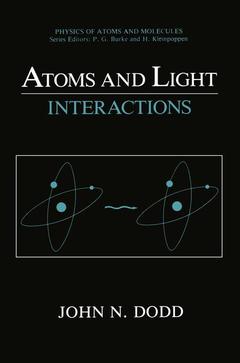Description
Atoms and Light: Interactions, Softcover reprint of the original 1st ed. 1991
Perspectives on Individual Differences Series
Author: Dodd John N.
Language: English
Publication date: 04-2013
219 p. · 15.5x23.5 cm · Paperback
219 p. · 15.5x23.5 cm · Paperback
Description
/li>Contents
/li>
This book discusses the interaction of light with atoms, concentrating on the semiclassical descriptions of the processes. It begins by discussing the classical theory of electromagnetic radiation and its interaction with a classical charged dipole oscillator. Then, in a pivotal chapter, the interaction with a free charge is described (the Compton effect); it is shown that, in order to give agreement with observation, certain quantum rules must be introduced. The book then proceeds to discuss the interaction from this point of view-light always being described classically, atoms described quantum-mechanically, with quantum rules for the interaction. Subsequent chapters deal with stimulated emission and absorption, spontaneous emission and decay, the general problem of light stimulating and being scattered from the two-state atom, the photoelectric effect, and photoelectric counting statistics. Finally the author gives a personal view on the nature of light and his own way of looking at certain paradoxes. The writing of this book was originally conceived as a collaboration between the present author and a colleague of former years, Alan V. Durrant. Indeed, some preliminary exchange of ideas took place in the mid-1970s. But the problems of joint-authorship from antipodean positions proved too difficult and the project was abandoned. I would like to record my indebted ness to him for the stimulation of this early association. I also acknowledge the encouragement of my colleagues at the Univer sity of Otago. Special reference must be made to D. M.
1 Introduction and History.- 2 Classical Radiation.- 3 The Oscillating Charge.- 4 Scattering of Radiation from a Charge Driven by an Electromagnetic Field.- 5 Intensity, Energy Density, the Poynting Vector, and Their Spectral Distributions.- 6 The Interaction of a Beam of Electromagnetic Radiation with a Free Electric Charge—The Compton Effect.- 7 The Quantum Structure of the Atom.- 8 The Einstein A and B Coefficients.- 9 The Semiclassical Treatment of Stimulated Absorption and Emission.- 10 The Semiclassical Description of Spontaneous Decay.- 11 The General Optical Transition.- 12 The Photoelectric Effect.- 13 Optical Coherence and Counting Statistics.- 14 What Is Light?.- Appendix 1 Time Averaging.- A1.1. Truncated Time Averaging.- A1.2. Exponential Averaging.- A1.3. Averaging over a Finite Time Interval.- A1.4. The Energy Density and Spectral Distribution of “Broad-Band” or “White” Light.- A1.5. The Monochromatic Field.- A1.6. The Modulated Field Arising from the Coherent Superposition of Two Frequencies.- Appendix 2 Ensemble Averaging.- Appendix 3 The Zero-Point Vacuum Field.- References.- Appendix 4 An Invariant form for Angular Momentum—Justification for Eq. (6.17).- Appendix 5 Functions.- A5.1. The Dirac Delta Function.- A5.2. The Exponential and the Lorentz Functions.- A5.3. The Square Pulse and the Fraunhofer Function.- A5.4. The Peaked Functions.- Appendix 6 Wave Functions and Bra-Kets.- Appendix 7 The Density of Waves in a Box.- A7.1. The Density of Electromagnetic Field Modes.- A7.2. The Density of Free Particle States.
© 2024 LAVOISIER S.A.S.




